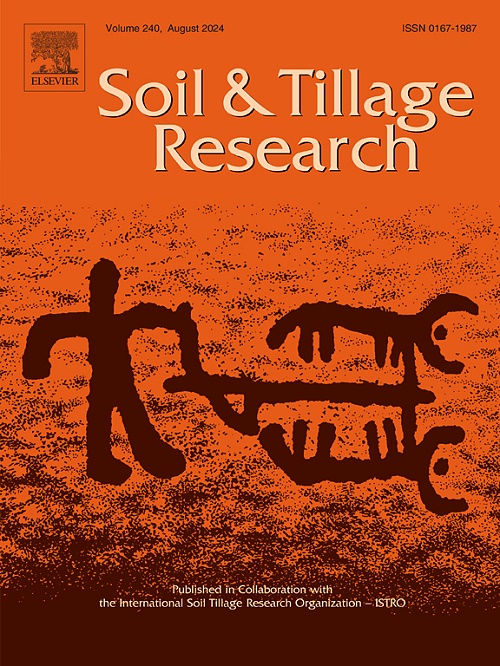The optimal DEM resolution for determining sediment connectivity at runoff plot scale
IF 6.8
1区 农林科学
Q1 SOIL SCIENCE
引用次数: 0
Abstract
Digital Elevation Model (DEM) resolution significantly influences the representation of surface topography and the assessment of sediment connectivity, which is crucial for understanding erosion processes and optimizing soil and water conservation (SWC) measures. However, the optimal DEM resolution for runoff plot sediment connectivity remains unclear, particularly in complex terrains such as the Loess Plateau. This study aimed to: (1) analyze the effects of varying DEM resolutions (2 cm to 100 cm) on sediment connectivity indices (IC) across different SWC measures and slope gradients; (2) identify the most suitable DEM resolution for sediment connectivity assessment at the runoff plot scale. Using high-resolution DEMs generated through UAV/Structure from Motion (UAV/SoFM) photogrammetry, the study encompassed 14 runoff plots (5 m×20 m) on the Loess Plateau. Results showed that IC values increased with coarser DEM resolution but stabilized beyond 20–30 cm, indicating the resolution-dependent nature of IC. The optimal DEM resolution varied with SWC measures: 20 cm for woodland with fish-scale pits, grassland under contour cultivation, and control plots without SWC, and 30 cm for farmland with horizontal ridging. Additionally, significant differences in IC values (P < 0.05) were observed among SWC measures, with control plots exhibiting the highest IC value (-2.18), indicating greater connectivity, while farmland under horizontal ridging exhibited the lowest IC (-3.20). These findings underscore the importance of selecting the appropriate DEM resolution for accurate sediment connectivity assessment and optimizing SWC measures to mitigate erosion. The results provide valuable insights for sediment connectivity evaluations at the runoff plot scale globally.
在径流地块尺度上确定泥沙连通性的最佳DEM分辨率
数字高程模型(DEM)分辨率显著影响地表地形表征和沉积物连通性评估,这对于理解侵蚀过程和优化水土保持(SWC)措施至关重要。然而,径流样地泥沙连通性的最佳DEM分辨率仍不清楚,特别是在黄土高原等复杂地形中。本研究旨在:(1)分析不同DEM分辨率(2 cm ~ 100 cm)对不同SWC测量值和坡度下沉积物连通性指数(IC)的影响;(2)在径流地块尺度上确定最适合泥沙连通性评价的DEM分辨率。利用无人机/动态结构(UAV/SoFM)摄影测量技术生成的高分辨率dem,研究了黄土高原14个径流样地(5 m×20 m)。结果表明,IC值随DEM分辨率的增加而增加,但在20 - 30 cm以上保持稳定,表明IC具有分辨率依赖性质。不同SWC措施的最佳DEM分辨率不同:有鱼鳞坑的林地、等高线栽培的草地和无SWC的对照样地的最佳DEM分辨率为20 cm,水平垄地的最佳DEM分辨率为30 cm。此外,不同SWC措施间的IC值存在显著差异(P <; 0.05),其中控制区的IC值最高(-2.18),表明连通性更强,而水平垄下农田的IC值最低(-3.20)。这些发现强调了选择合适的DEM分辨率对准确的沉积物连通性评估和优化SWC措施以减轻侵蚀的重要性。研究结果为全球径流地块尺度上的沉积物连通性评价提供了有价值的见解。
本文章由计算机程序翻译,如有差异,请以英文原文为准。
求助全文
约1分钟内获得全文
求助全文
来源期刊

Soil & Tillage Research
农林科学-土壤科学
CiteScore
13.00
自引率
6.20%
发文量
266
审稿时长
5 months
期刊介绍:
Soil & Tillage Research examines the physical, chemical and biological changes in the soil caused by tillage and field traffic. Manuscripts will be considered on aspects of soil science, physics, technology, mechanization and applied engineering for a sustainable balance among productivity, environmental quality and profitability. The following are examples of suitable topics within the scope of the journal of Soil and Tillage Research:
The agricultural and biosystems engineering associated with tillage (including no-tillage, reduced-tillage and direct drilling), irrigation and drainage, crops and crop rotations, fertilization, rehabilitation of mine spoils and processes used to modify soils. Soil change effects on establishment and yield of crops, growth of plants and roots, structure and erosion of soil, cycling of carbon and nutrients, greenhouse gas emissions, leaching, runoff and other processes that affect environmental quality. Characterization or modeling of tillage and field traffic responses, soil, climate, or topographic effects, soil deformation processes, tillage tools, traction devices, energy requirements, economics, surface and subsurface water quality effects, tillage effects on weed, pest and disease control, and their interactions.
 求助内容:
求助内容: 应助结果提醒方式:
应助结果提醒方式:


